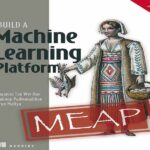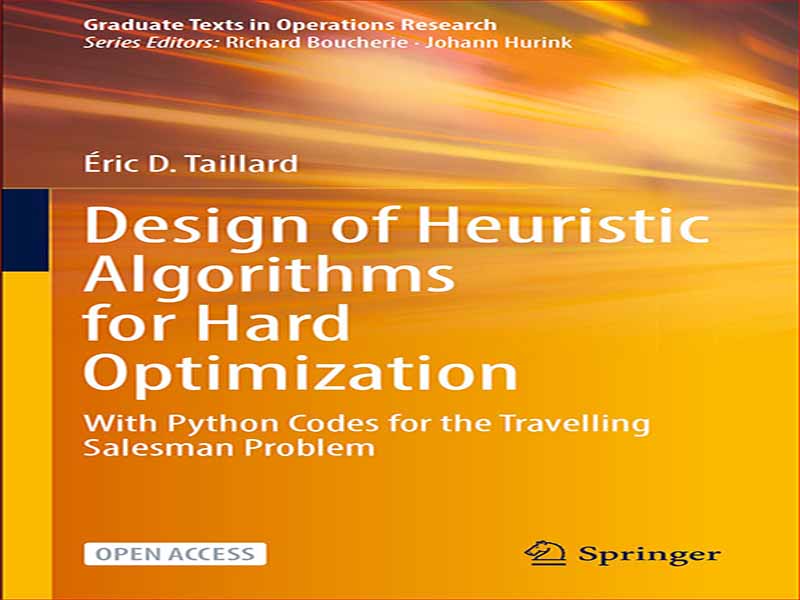- عنوان کتاب: Design of Heuristic Algorithms for Hard Optimization
- نویسنده: Éric D. Taillard
- حوزه: طراحی الگوریتم
- سال انتشار: 2023
- تعداد صفحه: 293
- زبان اصلی: انگلیسی
- نوع فایل: pdf
- حجم فایل: 14.7 مگابایت
این کتاب برای دانش آموزان، معلمان، مهندسان و دانشمندانی است که مایل به آشنایی با فراابتکاری هستند. غالباً فراابتکاری به عنوان یک فرآیند اصلی تکراری در نظر گرفته میشود که عملیات اکتشافیهای فرعی را هدایت و اصلاح میکند. در نتیجه، آثار در این زمینه در فصلهایی سازماندهی میشوند که هر کدام یک فراابتکاری، مانند بازپخت شبیهسازی شده، جستجوی تابو، کلونیهای مورچه مصنوعی یا الگوریتمهای ژنتیک را ارائه میکنند تا تنها بهترین شناختهشدهها را نام ببریم. این کتاب به فراابتکاری از زاویه ای جدید می پردازد. آنها را به عنوان مجموعه ای از اصول اساسی ارائه می دهد که با یکدیگر ترکیب می شوند تا یک الگوریتم اکتشافی طراحی کنند. هنگام پرداختن به یک مشکل جدید، سعی می کنیم آن را با بهره برداری از دانش به دست آمده از طریق تجربه حل کنیم. اگر مشکل به طور خاص دشوار به نظر می رسد، راه حلی که لزوما بهترین راه حل ممکن نیست پذیرفته می شود. مسئله این است که با یک تلاش محاسباتی معقول راه حل را کشف کنیم. سپس چنین روش تفکیک ابتکاری نامیده می شود. با تجزیه و تحلیل کل مجموعه ای از فراابتکاری پیشنهاد شده در ادبیات، ما پنج اصل اساسی اصلی را که منجر به طراحی یک الگوریتم جدید می شود شناسایی کردیم: 1. مدل سازی مسئله حساس ترین مرحله در مواجهه با یک مشکل جدید، مدل سازی آن است. در واقع، اگر یک مشکل توسط “پایان اشتباه” گرفته شود، حل آن می تواند تا حد زیادی به خطر بیفتد. طبیعتاً این مرحله در انحصار فراابتکاری نیست. 2. تجزیه به مشکل فرعی هنگامی که باید یک مسئله پیچیده یا نمونه ای با اندازه بزرگ را حل کرد، لازم است آن را به مسائل فرعی ساده یا کوچکتر تجزیه کرد. اینها ممکن است خودشان سخت باشند. از این رو، باید با یک تکنیک مناسب، به عنوان مثال یک فراابتکاری، به آنها نزدیک شد. 3. ساختن راه حل هنگامی که یک مدل مناسب یافت می شود، ساختن راه حلی برای مشکل آسان می شود، حتی اگر در عمل خوب نباشد یا حتی غیر قابل اجرا باشد. یکی از متداولترین روشهای ساخت، الگوریتم حریصانه است، که حتی ممکن است راهحلهای دقیقی برای مسائل ساده مانند حداقل درخت پوشا یا کوتاهترین مسیر ارائه دهد. این رویکرد را می توان به عنوان ترجمه ای به دنیای گسسته روش های گرادیان برای بهینه سازی متمایز پذیر دید. 5. تصادفی سازی و یادگیری در نهایت، تکرار ساخت و سازها یا اصلاحات، بهبود کیفیت راه حل های تولید شده را امکان پذیر می کند، مشروط بر اینکه یک جزء تصادفی و/یا یک فرآیند یادگیری درگیر باشد.
This book is intended for students, teachers, engineers and scientists wishing to become familiar with metaheuristics. Frequently, metaheuristics are seen as an iterative master process guiding and modifying the operations of subordinate heuristics. As a result, the works in the field are organized into chapters, each presenting a metaheuristic, such as simulated annealing, tabu search, artificial ant colonies or genetic algorithms, to name only the best known. This book addresses metaheuristics from a new angle. It presents them as a set of basic principles that are combined with each other to design a heuristic algorithm. When addressing a new problem, we try to solve it by exploiting the knowledge acquired by experience. If the problem seems peculiarly difficult, a solution that is not necessarily the best possible is accepted. The matter is to discover the solution with a reasonable computational effort. Such a resolution method is then called a heuristic. By analysing a whole menagerie of metaheuristics proposed in the literature, we identified five major basic principles leading to the design of a new algorithm: 1. Problem modeling The most delicate phase when confronted with a new problem is its modeling. Indeed, if a problem is taken by the “wrong end,” its resolution can be largely compromised. Naturally, this phase is not the prerogative of metaheuristics. 2. Decomposition into sub-problem When one has to solve a complex problem or an instance of large size, it is necessary to decompose it into simpler or smaller sub-problems. These may themselves be difficult. Hence, they must be approached by an appropriate technique, for example a metaheuristic. 3. Building a solution When a suitable model is found, it becomes easy to build a solution to the problem, even if it is not good or even inapplicable in practice. One of the most common constructionmethods is a greedy algorithm, which may even provide exact solutions for simple problems such as the minimum spanning tree or the shortest path. 4. Modifying a solution The next step tries to improve a solution by applying slight modifications. This approach can be seen as a translation to the discrete world of gradient methods for differentiable optimization. 5. Randomization and learning Finally, the repetition of constructions or modifications makes it possible to improve the quality of the solutions produced, provided that a random component and/or a learning process are involved.
این کتاب را میتوانید از لینک زیر بصورت رایگان دانلود کنید:
Download: Design of Heuristic Algorithms for Hard Optimization



































نظرات کاربران